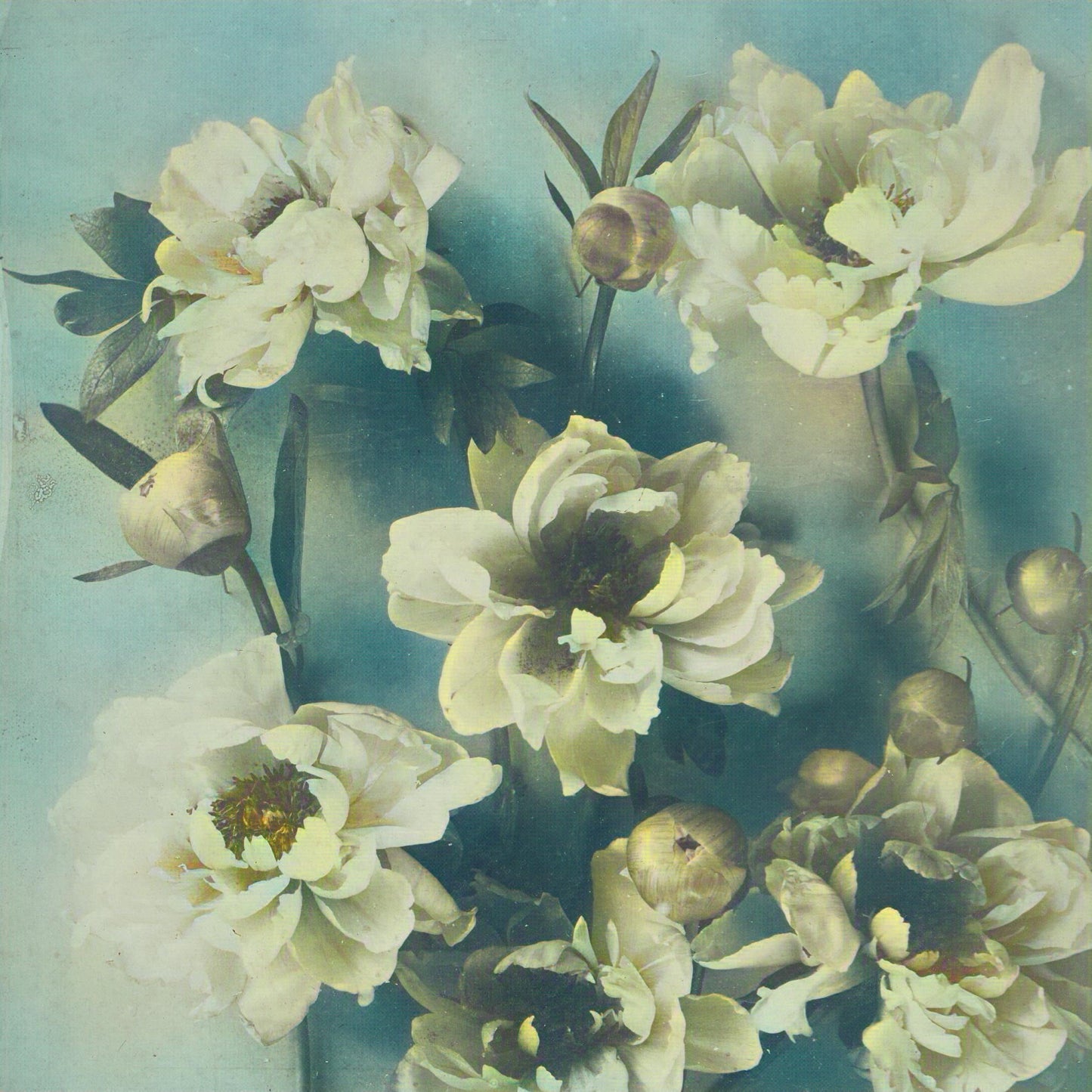
Tiffany's Peony lamp shades stand as an exquisite testament to Louis Comfort Tiffany's mastery of both artistry and horticulture. The shades were decorated with three different peony cultivars, both grown at Louis Comfort Tiffany’s garden estate, Laurelton Hall. Under his direct supervision, thirty-five full-time gardeners painted the earth with polychromatic blooms. The first peony was the noble Greek Peony (Paeonia parnassica), favored by Tiffany for its symmetry and simplicity. The Greek Peony decorated the column capitals of Laurelton Hall’s loggia, which can now be seen in the Charles Engelhardt court of the Metropolitan Museum of Art.

Left: Design drawing of peony blossom of floral capital from loggia, Laurelton Hall, ca. 1905, Metropolitan Museum of Art, Right: Architectural Elements from Laurelton Hall, Oyster Bay, New York, Charles Engelhardt Court
The second cultivar was a candy-striped Japanese peony named Shima Nishiki (Island Brocade). The arrival of Commodore Perry's ships in 1853 unleashed a surge of interest among Horticultural associations, plant companies, and amateur enthusiasts, marking the beginning of the “golden age of plant hunting” in Japan. Among the most desirable of plant species was the tree peony (Paeonia suffruticosa), which after their introduction from China, had been lovingly bred into a bevy of textures, colors, and patterns.
The candy stripes of the Shima Nishiki cultivar were meant to emulate scintillating metal warp threads weaved into mulberry paper. The bloom is characterized by its pink and red candy stripes, a coloration emulated through the use of "Streaky" glass. "Streaky" glass was a special variety of Tiffany glass created by ladling strings of hot glass onto the glass of a contrasting color.

Top Left: Coral Peony (Paeonia mascula) on Tiffany Studios Peony Lamp (Detail), Top Right: Wild Coral Peony (Paeonia mascula), Photography by Georgios Kouvelis, Bottom Left: Shima Nishiki on Tiffany Studios Peony Lamp (Detail), Bottom Right: Paeonia suffruticosa ‘Shima Nishiki’ , Primrose Hall Peonies
The third cultivar depicted by Tiffany was the Cup of Shining Night, a flower given to Tiffany’s gardener John Miller by Dr. Joseph Rock (1884-1962). Rock first encountered the flower in the courtyard of Chone Monastery in Gansu Province. The Cup of Shining Night is a wine-red cup-shaped peony named after the legendary wine cup from Wang Han’s poem, “A Song of Liangzhou.” The Cup of Shining Night was a red amber cup that would absorb the fragrance of wine, carrying its past to the drinker’s senses. Wang’s poem embodies his melancholic sentiment about life on the battlefield. In a stroke of poetic cyclicity, a flower whose name was inspired by a wine cup had yet again inspired a glassmaker halfway around the world. Of particular note is the nuance of color in each peony bloom. The change of color in a peony’s life was observed by Ouyang Xiu (1007-1072): “Purple at first bloom, later, peach blossom pink, brighter red with each passing day, deep red at last petal’s fall.” Accordingly, Tiffany’s lamp shade elegantly depicts different stages of growth from the bud, first bloom, peak bloom, to wilting. When peony petals wilt, their veins darken, and their form puckers. Tiffany’s glass selectors chose a stone textured glass called granite glass to express the wilting of the petals and their pronounced venation.

Tiffany's Peony Lamps represented a fusion of cultural influences, embodying his profound appreciation for the classical beauty of Greco-Roman art alongside the rich philosophies and aesthetics of Eastern art. Inspired by his gardens, which he viewed as miniature reflections of the diverse world around him, Tiffany curated a harmonious blend of native flora and timeless blooms, creating a botanical tapestry that echoed the artistic inspirations of generations past. In each delicate petal and intricately wrought detail of the lamps, one could discern not only Tiffany's mastery of craftsmanship but also his reverence for the enduring motifs that have captivated artists and admirers alike throughout history.












